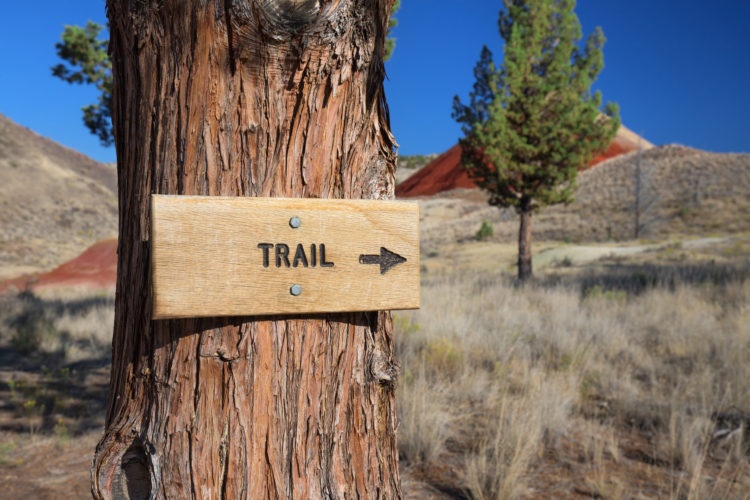
Hiking is a popular activity in Central Oregon for many because of the low impact stress it has on the body, and it’s an easy activity for a variety of age groups and skill levels. Participating in any physical activity always comes with the potential for injury, even for hikers. If hiking is a favorite summertime activity for you, being aware of common musculoskeletal injuries caused by hiking may help you continue down your favorite path or trail pain free.
Common Hiking Injuries
It’s no surprise that foot injuries are the most common types of injuries found among eager hikers. Injuries to other parts of the body can also occur, but when hiking, your lower body takes the majority of impact. Some common injuries affecting the lower extremities include:
Lower Leg and Foot Stress Fractures
Stress fractures are one of the most common sports injuries. A stress fracture is an overuse injury that occurs when muscles become fatigued and are unable to absorb shock and protect the bones as they usually do. When stress is placed on fatigued muscles, eventually the overload of stress is transferred to the bone, causing a tiny crack or stress fracture. Stress fractures most commonly occur in the weight-bearing bones of the lower leg and foot.
Prevention Tips:
- Gradual Progression: Gradually increase the intensity and duration of your hikes to allow your muscles and bones to adapt.
- Proper Footwear: Wear supportive hiking boots that provide cushioning and absorb shock.
- Rest and Recovery: Ensure adequate rest between hikes to allow your body to recover and strengthen.
Plantar Fasciitis
Plantar fasciitis is the most common cause of foot pain, radiating from the bottom of the heel throughout the foot. The plantar fascia is the strong band of tissue in the arch of your foot, which runs from your heel to toe and absorbs strains and stress placed on the foot each time it is in use. Plantar fasciitis occurs when that supporting tissue becomes irritated and inflamed.
Prevention Tips:
- Stretching: Regularly stretch your calves and the bottom of your feet to maintain flexibility.
- Supportive Shoes: Use shoes with good arch support and cushioning, especially if you have flat feet or high arches.
- Gradual Increase in Activity: Avoid sudden increases in hiking intensity or duration.
Foot and ankle specialist, Dr. Anthony Hinz, discusses his treatment for plantar fasciitis.
Sprained Ankle
Because our feet and ankles are constantly supporting the weight of our bodies, they tend to undergo a lot of wear and tear. We have several ligaments in our ankle that can be stretched or torn when the ankle is forced into an awkward position. Typically, a sprain results when the ankle is rolled inward or outward. Ankle sprains can range from mild to severe, depending upon how much damage occurs.
Prevention Tips:
- Strengthening Exercises: Perform exercises to strengthen the muscles around your ankle and improve balance.
- Watch Your Step: Pay attention to the trail to avoid tripping on roots, rocks, or uneven surfaces.
- Proper Footwear: Wear boots with good ankle support to stabilize your foot and ankle.
Toe Fracture
The proximal phalanx is the toe bone on each toe that is closest to the metatarsals. Because it is the longest of the toe bones, it is the most likely to fracture. A fractured toe may become swollen, tender and discolored. If the bone is out of place, your toe will appear deformed. Most broken toes can be treated symptomatically.
Prevention Tips:
- Proper Footwear: Choose sturdy shoes with a wide toe box to protect your toes from impact.
- Avoid Overloading: Be mindful of where you step and avoid kicking rocks or other hard objects.
- Taping: In some cases, taping your toes can provide additional support and prevent injury.
Achilles Tendinitis
Achilles tendinitis is a common condition that occurs when the large tendon that runs down the back of your lower leg becomes irritated and inflamed from repetitive stress on the tendon. Pain along the tendon or back of the heel may worsen with activity, and you may experience severe pain the day after a long hike.
Prevention Tips:
- Strengthening and Stretching: Regularly perform exercises to strengthen your calf muscles and stretch your Achilles tendon.
- Gradual Increase in Activity: Gradually increase your hiking intensity to avoid overloading the tendon.
- Proper Footwear: Ensure your hiking boots provide adequate heel support and cushioning.
Foot and ankle specialist, Dr. Anthony Hinz, discusses achilles tendinitis including the causes, symptoms, and treatment options in this short video.
Knee Injuries
Knee injuries are another common concern for hikers, especially on uneven terrain or steep inclines and declines. The knee joint is complex and bears a significant amount of stress during hiking.
Common Knee Injuries:
- Patellofemoral Pain Syndrome (PFPS): Also known as “runner’s knee,” this condition involves pain around the kneecap due to misalignment or overuse.
- Meniscal Tears: The meniscus is cartilage in the knee that can tear due to twisting movements or heavy loads.
- Ligament Injuries: Ligaments such as the ACL or MCL can be sprained or torn during hiking, particularly on uneven ground.
Prevention Tips:
- Strengthening Exercises: Focus on exercises that strengthen the muscles around the knee, including quadriceps, hamstrings, and calves.
- Use Trekking Poles: Trekking poles can help reduce the load on your knees, especially during descents.
- Proper Technique: Maintain good hiking form, keeping your knees slightly bent and avoiding locking them.
How to Prepare for a Hike
Preparation is key to preventing injuries and ensuring a safe and enjoyable hiking experience. Here are some essential tips to help you get ready for your next adventure:
Physical Preparation
- Build Endurance: Start with shorter hikes and gradually increase the distance and difficulty to build your endurance.
- Strength Training: Incorporate exercises that strengthen your core, legs, and upper body to handle the demands of hiking.
- Flexibility and Balance: Include stretching and balance exercises in your routine to improve your overall stability and flexibility.
Gear and Equipment
- Proper Footwear: Invest in quality hiking boots that provide support, cushioning, and good traction.
- Clothing: Dress in layers to adapt to changing weather conditions. Choose moisture-wicking fabrics to stay dry and comfortable.
- Backpack: Use a well-fitted backpack to distribute weight evenly. Pack essentials like water, snacks, a first aid kit, and navigation tools.
Trail Knowledge and Safety
- Research the Trail: Familiarize yourself with the trail’s difficulty, length, and any potential hazards. Check for recent trail conditions and weather updates.
- Plan Your Route: Share your hiking plans with someone and stick to your planned route. Avoid hiking alone, especially on unfamiliar trails.
- Stay Hydrated and Nourished: Carry enough water and snacks to keep your energy levels up throughout the hike.
Injury Prevention Strategies
- Warm-Up and Cool Down: Always start your hike with a warm-up to prepare your muscles and end with a cool down to aid recovery.
- Pace Yourself: Avoid rushing and maintain a steady pace that you can sustain for the duration of the hike.
- Listen to Your Body: Pay attention to any signs of discomfort or fatigue. Take breaks as needed and avoid pushing through pain.
If any of your pains or injuries do not show improvement or continue to get worse over time, it is important to schedule an appointment with an orthopedic specialist to be treated properly.
Stay informed about upcoming webinars and events, and gain valuable insights on leading a healthy, pain-free life from our experts by subscribing to our monthly newsletter. Click the button below to join!





